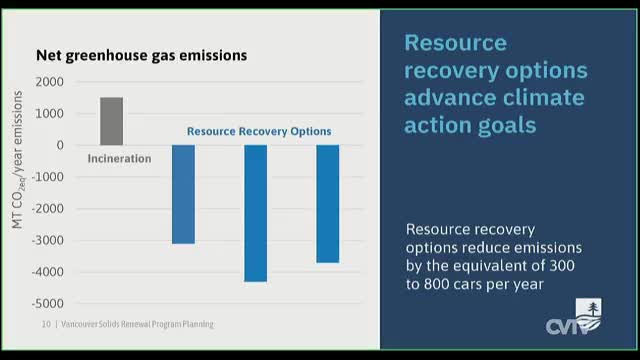City plans innovative waste digestion facility to cut emissions
June 17, 2024 | Vancouver, Clark County, Washington

This article was created by AI summarizing key points discussed. AI makes mistakes, so for full details and context, please refer to the video of the full meeting. Please report any errors so we can fix them. Report an error »

In a recent government meeting, officials discussed the implementation of resource recovery options aimed at reducing greenhouse gas emissions associated with waste management. The proposed initiatives are expected to offset emissions equivalent to 300 to 800 cars annually, primarily through carbon sequestration in soil and the generation of renewable gas, which would replace fossil fuel usage.
The meeting highlighted the need for an implementation plan that would outline the technological components and investment phases necessary to balance costs and benefits. City staff emphasized the importance of engaging with the Fruit Valley community, where the Westside facility is located, to gauge local perceptions and address potential neighborhood impacts. This outreach is particularly crucial as the community ranks high on the city's vulnerability index.
Officials are exploring external funding sources, including grants and loans, alongside revenue from natural gas production to support the project. The timeline aims for the new digestion facility to be operational by 2033, coinciding with the end of the current incinerator's life cycle.
Concerns regarding heavy metals in biosolids were also addressed, with assurances that existing EPA regulations, established since the 1980s, ensure safe land application practices. The discussion included a call for urgency in transitioning from the current incineration method, which is known to produce significant greenhouse gas emissions.
As the city moves forward, the council is expected to provide feedback on the recommended pathway for resource recovery, with further discussions anticipated in the coming months.
The meeting highlighted the need for an implementation plan that would outline the technological components and investment phases necessary to balance costs and benefits. City staff emphasized the importance of engaging with the Fruit Valley community, where the Westside facility is located, to gauge local perceptions and address potential neighborhood impacts. This outreach is particularly crucial as the community ranks high on the city's vulnerability index.
Officials are exploring external funding sources, including grants and loans, alongside revenue from natural gas production to support the project. The timeline aims for the new digestion facility to be operational by 2033, coinciding with the end of the current incinerator's life cycle.
Concerns regarding heavy metals in biosolids were also addressed, with assurances that existing EPA regulations, established since the 1980s, ensure safe land application practices. The discussion included a call for urgency in transitioning from the current incineration method, which is known to produce significant greenhouse gas emissions.
As the city moves forward, the council is expected to provide feedback on the recommended pathway for resource recovery, with further discussions anticipated in the coming months.
View full meeting
This article is based on a recent meeting—watch the full video and explore the complete transcript for deeper insights into the discussion.
View full meeting
